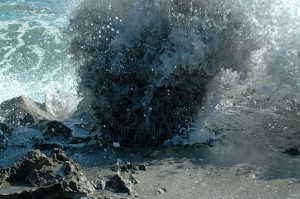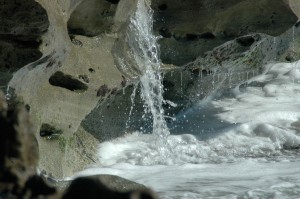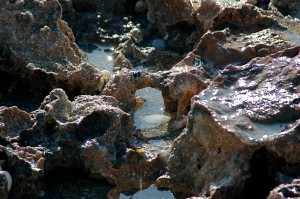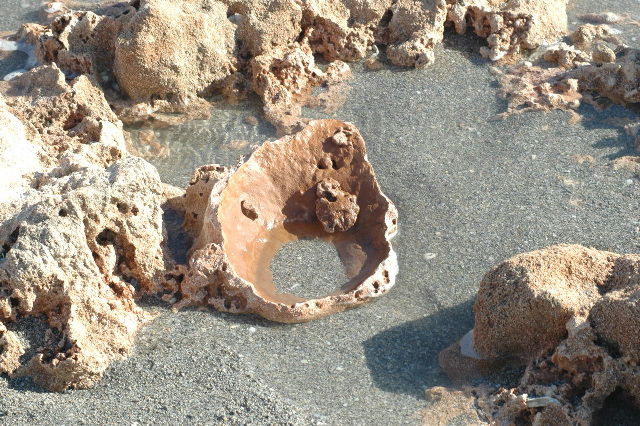In an article last year about Montana de Oro state park in California, I discussed how the land there includes a series of uplifted marine terraces. Those terraces are formed by a combination of geologic uplift at periodic intervals and the eroding action of the shoreline.
Well, here in Florida we’re pretty conversant with the eroding action of the shoreline. But for most of the east coast, at least, the forces of erosion and deposition are pretty much balanced. What the waves take away in the winter, they deposit in the summer, or vice versa. And in parts of the coast where the underlying limestone is exposed, you can actually observe the process of lithification taking place at the same time as you see wave action eroding the rocks!
A terrific example of this state of affairs can be found at Blowing Rocks Preserve, in Jupiter, Florida. It’s very exciting to see the waves crashing into the rocks, scouring them and undercutting the Anastasia limestone terrace (of Pleistocene origin); it’s easy to tell why this is called a high-energy coastline:


The beach here is really something, with waves crashing into the limestone down below, while up above, the overwash creates tidepools where the sun and the salt water combine to cement the calcium carbonate shells of the marine mollusks into the cementitious rock known as coquina. The process can create some incredible combinations of erosion and formation at the same time, like this mini-arch in a tidepool on top of the limestone terrace:

Or this coquina “crater”; hard to tell whether it looks more like a volcanic or an impact crater on the moon, or perhaps the top of a fossilized sponge:

The Anastasia formation, though, isn’t one of Florida’s recognized marine terraces; I’m not clear on why. Apparently, it’s just a limestone formation because it’s not exposed at the surface for its entire length? (See this article on raised beaches in Wikipedia, which equates the terms raised beach and marine terrace.)
Basically, marine terraces form through a combination of sea- and land-level changes with the action of erosion or deposition. Marine erosion creates features like wave-cut benches, sea cliffs, and rocky headlands, all of which are on display at Montana de Oro; not so much here in South Florida.
According to Anderson et al. (1999), marine terraces form when:
- Sea-cliff retreat driven by wave erosion creates a wave cut platform.
- The platform is abandoned when sea level drops leaving behind marine sediments covering a planar bedrock surface.
- If tectonic uplifts rates are large enough, the old wave-cut platform has been lifted out of the surf zone by the next sea level highstand and the terrace is then preserved in the landscape.
- Thus, a flight of marine terraces records the history of tectonic uplift and sea level fluctuation
Whatever the geologic explanation, exploring the beach is fun, and you can do it close to home, too. Further south in Palm Beach County, in my own town of Boca Raton, in fact, we can see a little bit of the formation at South Beach Park.
And, if you’re curious, Florida’s defined marine terraces, from Randazzo & Jones, are:
- Silver Bluff (1—3 m elevation)
- Pamlico (2.5—7.6 m)
- Talbot (7.6—12.8 m)
- Penholoway (12.8—21.3 m)
- Wicomico (21.3—30.4 m)
- Sunderland/Okeefenokee (30.4—51.8 m)
- Coharie (51.3—65.5 m)
- Hazlehurst (65.5—97.5 m)
One of these days, I might even be able to take some field trips to see them! But first, I need to digest the article by Alt and Brooks linked to above; it seems to explain some of the problems of interpreting marine terraces.
